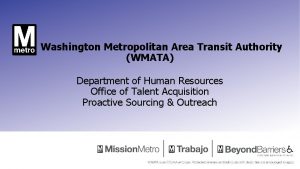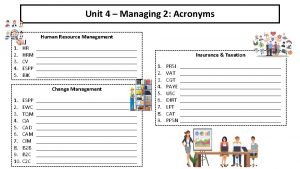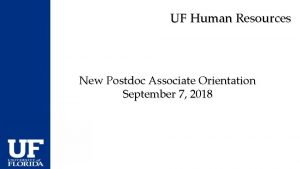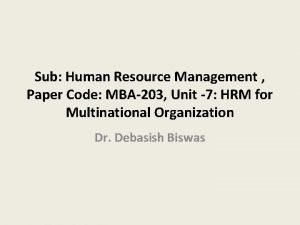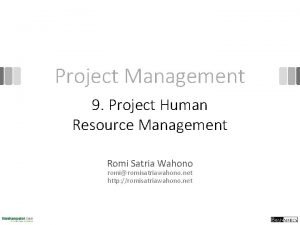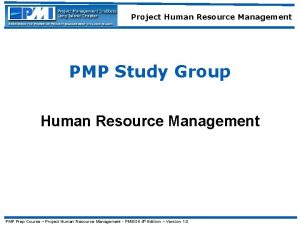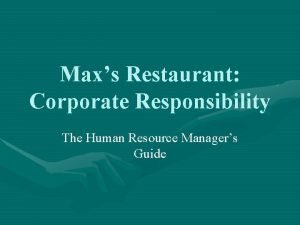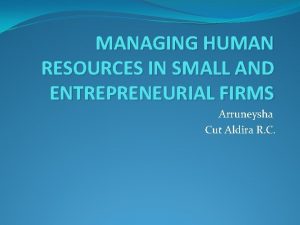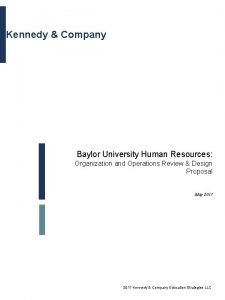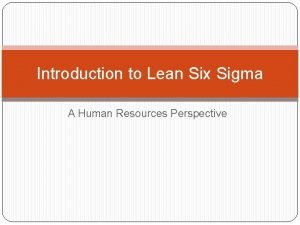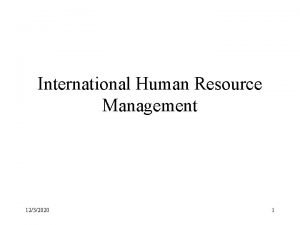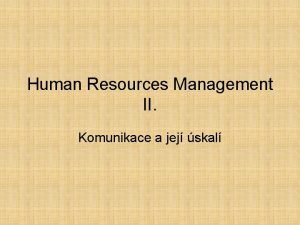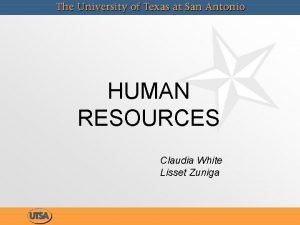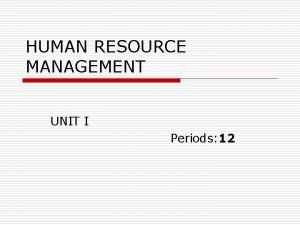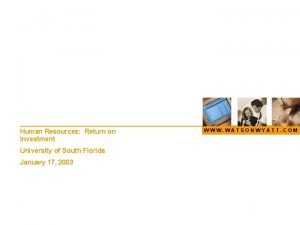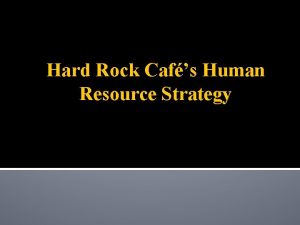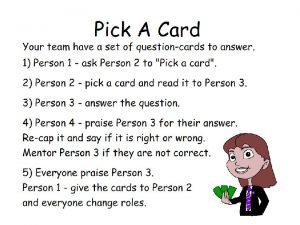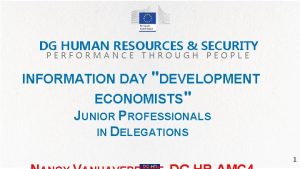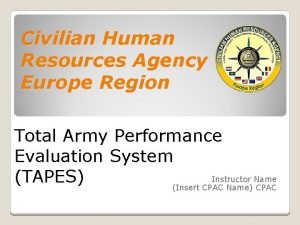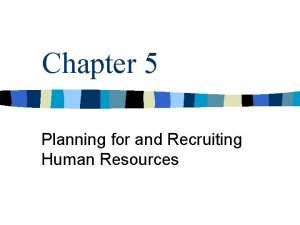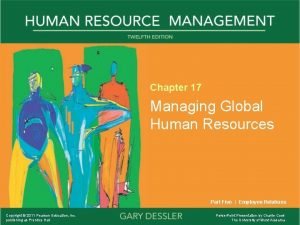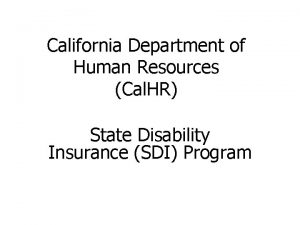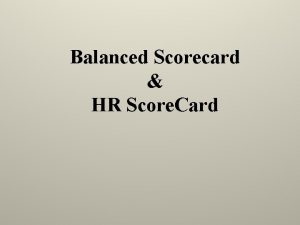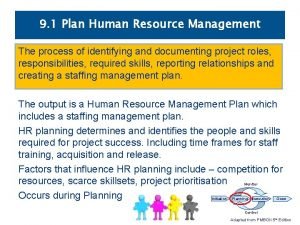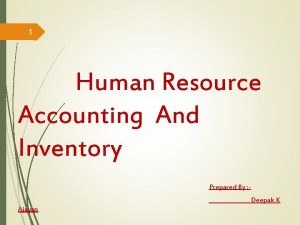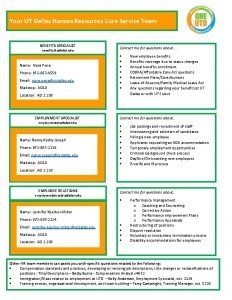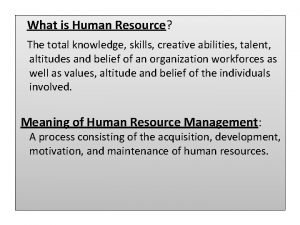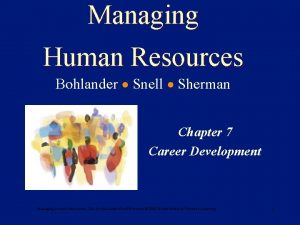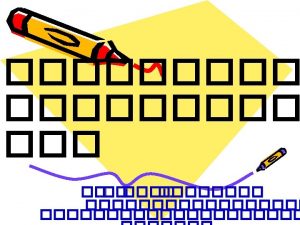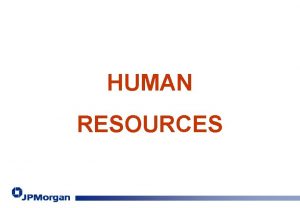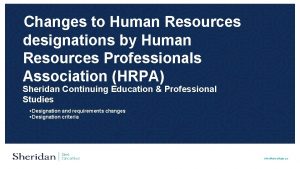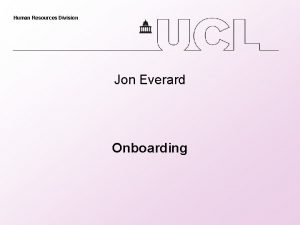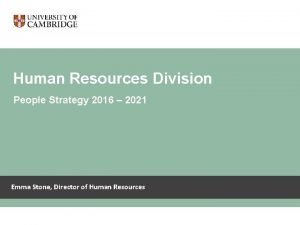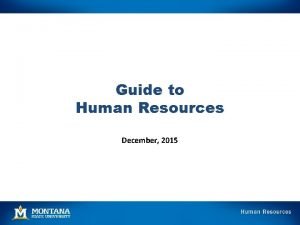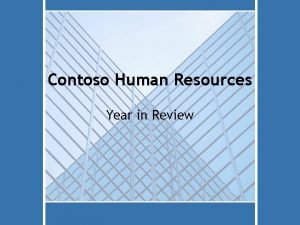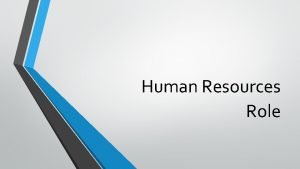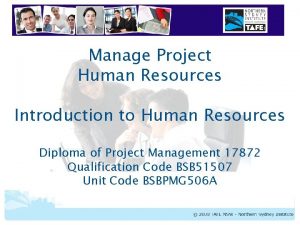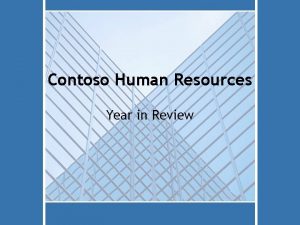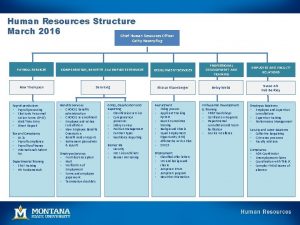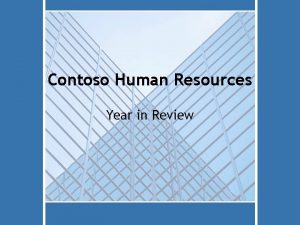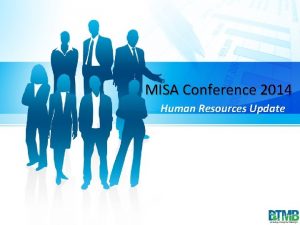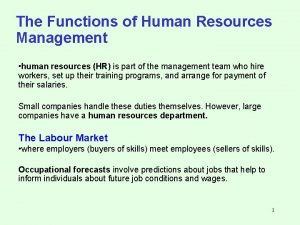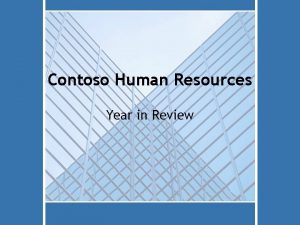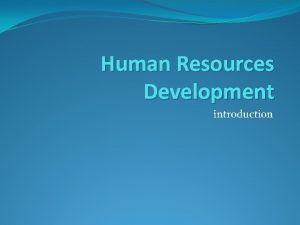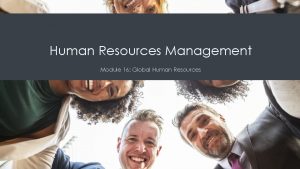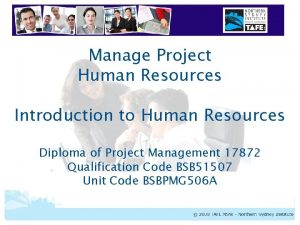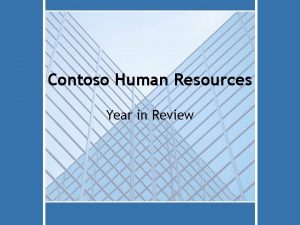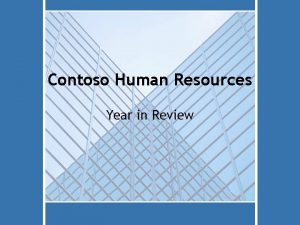Unit 2 3 Communication Human Resources Communication Is



















































- Slides: 51

Unit 2. 3 Communication Human Resources

Communication Is the transfer of information between different people and between businesses. Effective communication is the exchange of information between people or groups, with feedback. The purposes and objectives of communication include to instruct, clarify, interpret, notify, warn, receive feedback, review and to inform.

Effective Communication • • • sender (or transmitter) of the message clear message appropriate medium (way in which the message is sent) receiver feedback to confirm receipt and understanding

Importance of effective communication Staff motivation and labor productivity - if staff are encouraged to participate through group discussion, for example, then effective communication will aid motivation. The number and quality of ideas generated by the staff – if staff are asked for their ideas, then this can assist with problem-solving. Speed of decision making – the more people who have to be communicated with, the slower the decision-making system.

Importance of effective communication Speed of response to market changes – if changes in consumer tastes take a long time to be communicated to the main decisionmakers, then the business will be slow to respond with appropriate products. Reduces the risk of errors – incorrect understanding of a poorly expressed message will lead to incorrect responses. This could lead to many internal problems, such as the wrong products being made or incorrect prices being set.

Importance of effective communication Effective co-ordination between departments – this will be helped by good communication links between them. Note: Poor communication will lead to demotivated staff, uncoordinated departments, poor customer service and a lack of overall direction for the organization.

Communication Media Methods used to communicate a message Ø Oral Ø Written Ø Visual Ø Non-verbal Ø Formal and informal communication Ø Information and communication technology (ICT)

Oral (verbal) Communication Involves people talking and listening to one another. It is quick because the sender and receiver are usually in direct contact with each other. It allows questions to be asked, and for feedback and clarification to be given. How well the message is communicated depends on the skills of the speaker, such as the use of jargon or the tone of voice.

Samples of verbal communication Giving instructions or information Discussing problems Business meetings Job interviews Job appraisal and feedback Oral presentations People simply talking to each other

Advantages of oral communication There is very little, if any, cost involved Detailed questions can be asked Questions can be answered without much delay Interviews and presentations help to judge an employee’s ability to communicate Facial reactions and body language, along with tone of voice, can often be judged

Disadvantages of oral communication There is no permanent record of the conversation for future reference The information given might not always be complete or truthful Confidential messages can be difficult to communicate verbally, especially when many people are involved Meetings and interviews can be very time consuming

Written Communication Refers to non-verbal communication methods: Ø Ø Ø Ø Letters Memorandum Reports Notices Executive Summaries Abstracts Research Proposals

Letters Business letters should: Indicate the name and address of the sender Include the date Have a reference (a focal point or a reference number) Include proper salutations: ‘Dear Sir/Madam… Yours faithfully’ or ‘Yours Sincerely’… Letters provide a hard copy that can be kept for future reference. They are specific and can address issues in great detail. Can be time consuming to produce and might take awhile to get a response from the receiver.

Memorandum A business note from one person to another Can be formal or hand written message Memos are used for internal purposes (ex. Meetings or send a reminder or pass on a quick message) Can be very quick to produce Messages are short, specific and easy to understand Not useful for passing on long and complicated information

Reports Formal method of written communication Ø A front title page (name of the author of the report, the audience it is targeted and the date of the report) Ø An executive summary of what the report is about and the purpose of the research) Ø Contents page with page numbering Ø An introduction to the report Ø Section headings to separate parts of the report Ø Conclusions and perhaps recommendations Ø A bibliography listing all sources of reference Ø An appendix with supplementary evidence (ie. Quantitative research data)

Reports Are prepared in detail for a specified audience and this makes communication direct and easy to understand. It can take a long time to investigate and write the report, by which time any findings or recommendations made might be outdated.

Notices Used when a message needs to reach a range of people (via postings or on a company website) Can be formal or informal Useful for passing on messages so that everyone can see Can contain a lot of important information that can be left as a reminder to staff Notices are not confidential and old messages are often ignored

Executive Summaries Written to provide a condensed version of a report’s content. Gives executives easy and fast access to information Must be accurate as they are stand-alone documents so managers might make decisions based on the contents of the executive summary without reading the original report Format: Ø Ø Scope and purpose of report Methodology Main results and findings Conclusions and recommendations

Abstracts Written as a condensed (shortened) version of a report without losing the original message of the report Does not directly provide any recommendations to aid decision making Shorter than executive summaries

Research Proposals Planning document Sets out the keys to be investigated May contain: details of primary and secondary methods of research An action plan with dates Identification of any foreseeable problems likely to be encountered in the investigation Disadvantage with written communication is the issue of storage

EXAM TIP! Students are expected to be able to prepare different forms of written communication such as memoranda, reports and executive summaries. There are usually marks allocated for displaying an understanding of the correct format of these written methods.

Visual Communication Refers to communication methods that use visual images and stimuli, such as poster displays or a person’s body language Used to enhanced communication Ø Can be understood relatively easily Ø Can communicate ideas quicker than words Ø Often cheaper to produce Ø Cater for visual learners Ø Can have longer lasting impact

Samples of Visual Communication Bar chart, pie chart, lie graph, histogram Photographs Symbols Tables Maps Sketches Diagrams Sign language and body language

Exercise Question 2. 3. 1 page 206

Non-verbal Communicaton Except for oral communication, all forms of communication can come under the category of non-verbal communication Written and visual communication Use of information and communication technology

Channels of communication Method of communication: Ø Informal – unofficial communication channels that exist among informal groups (not necessarily relate directly to work matters) Ø Formal – official channel of communication (directly related to work matters) ²Open channels – not confidential ²Restricted channels – confidential

Benefits of informal communication Foster a sense of belonging in the workplace Foster a sense of security and mutual support Pooling of ideas can help to generate solutions that might not have occurred through more formal communication channels (people tend to be open during informal discussions)

Alternative views of informal communication

ICT Electronic mail (email) Fast method of communication Set up cost can be high; might not be secure Facsimile (fax) Quick and convenient but needs fax paper and ink cartridges Less popular due to cheaper alternative Video-conferencing Efficient and cuts travel time and costs Initial start-up cost can be high Telephones and mobile phones Popular means of communication International calls can be expensive

Drawbacks of electronic media They might require staff to be trained, and the young are usually much more proficient in their use than older employees. They reduce social contact and can create a sense of isolation and an important social need may go unsatisfied. Staff may use company time to send personal messages. There are security issues with computer technology and hard copies of important messages are often kept in case of a virus. There is increasing evidence that IT can lead to information overload as a result of the speed and low usage cost of these methods (can cause stress and feeling of overwork).

Exercise Question 2. 3. 2 page 207


Factors influencing the choice of communication method Personal preferences Size of business Organization structure Storage issues Security issues and concerns Location Skills and training Urgency Ease of use cost

Barriers to effective communication High costs Geographical location Technological breakdowns Internal politics Language Poor presentation skills Accents Poor or negative body language Jargon Cultural ignorance Technophobia ‘Chinese whispers’ Physiological barriers

Reasons for barriers and ways to reduce them

• The medium chosen might be inappropriate. If the message contained detailed technical language and flow diagrams, trying to explain these over the phone could lead to incorrect understanding. • Solution: Select appropriate medium for the message.

• If a receiver forgot part of a long message given to him or her orally, then a written form would have been more appropriate. • Solution: Use written form when the message is long or complex.

• A misleading or an incomplete message would result in poor understanding – ‘send the goods soon’ may be interpreted as being tomorrow when in fact the sender meant ‘now, or as soon as possible’. • Solution: Consider the clarity of the message carefully.

• The excessive use of technical language or jargon – terms that are understood by a specific group but not by others – may prevent the receiver from being able to comprehend what is required. Messages sent to branches or staff in another country may not be understood unless they are translated into the local language. • Solution: Avoid using jargon where possible

• If there is too much information – perhaps more than is actually necessary for the receiver to respond in the right way – the threat of information overload leads to ‘noise’, that is unnecessary data, which prevents the receiver from grasping the key elements of the message. • Solution: Highlight important messages, and consider not sending less important ones.

• If the channel of communication is too long – the channel is the route through which a message is communicated from sender to receiver, as in tall hierarchical organizations – then messages will be slow to reach their intended receiver and they may become distorted or change their meaning on the way. • Solution: Shorter chains of command (ie. through delayering) will reduce the risk of distortion.

• If the sender is not trusted – perhaps because of previous misleading messages or unpopular decisions – then the receiver may be unwilling to listen to or read the message carefully. In addition, unmotivated or alienated workers make poor receivers. If workers have never been consulted on important issues before, then they may become very suspicious if the management style seems to be changing toward a more participative one. Workers with little interest in their work will not want to take the trouble to ensure that communication is effective. • Solution: Establish trust between senders and receivers – this could be most easily achieved in a business where all staff are considered to be important with useful contributions to make.

• Intermediaries – those in the communication channel – may decide not to pass on a message, or to change it, if they are poorly motivated. This could occur, for example, if there has been a supplier’s query about an order or a customer complaint. • Solution: Keep the communication channel as short as possible and ensure feedback is built into the system.

• The sender may have such a poor opinion or perception of the receiver that no effort is made to ensure clarity of message or to check on understanding. • Solution: Train and motivate staff to take an active part in communication process.

• Noisy factories are not the best environment for communication. This indicates that the poor quality of the external environment can limit effective communication. • Solution: Physical conditions should be appropriate for messages to be heard or received in other ways.

• Geographical distance can inhibit effective communication – interpersonal communication in particular will be very difficult. • Solution: Modern electronic methods, such as video conferencing, are designed to overcome this barrier.

Exercise Question 2. 3. 3 page 210

Consequences of poor communication Low morale will exist as staff feel out of touch, lose confidence, have a lack of direction and feel undervalued Errors will rise as staff are not fully aware of what they have to do There will be a loss of competitiveness due to lower productivity (caused by poor morale and the increase in errors & reworking) Lack of control can transpire as staff may need clear instructions from their managers

Possible ways to solve communication problems Managers must first look at the causes of the communication breakdown Delayering by removing layers of supervisors and management from the hierarchy to improve speed and accuracy of communication Recruit bilingual or multilingual employees

Exercise Question 2. 3. 4 page 211

Additional Resource • http: //www. ibbusinessandmanagemen t. com/23 -communication. html
 What is transformed resources
What is transformed resources Fixed and variable resources examples
Fixed and variable resources examples Renewable vs nonrenewable resources worksheet
Renewable vs nonrenewable resources worksheet Unit 6 review questions
Unit 6 review questions Wmata human resources
Wmata human resources Human resources acronyms
Human resources acronyms Uf hr
Uf hr Difference between hrm and ihrm
Difference between hrm and ihrm Project management human resources
Project management human resources Project human resource management definition
Project human resource management definition Human resources and job design
Human resources and job design Hrm importance
Hrm importance Human resource management in restaurants
Human resource management in restaurants Managing human resources in small and entrepreneurial firms
Managing human resources in small and entrepreneurial firms Empower human resources
Empower human resources Baylor university hr
Baylor university hr Lean six sigma hr
Lean six sigma hr Resource management definition
Resource management definition Human resources videregående uddannelser
Human resources videregående uddannelser Example of short term human resources
Example of short term human resources Historie human resources
Historie human resources Chapter 9 human resources management
Chapter 9 human resources management Human resources claudia
Human resources claudia Fombrun model
Fombrun model Human resource management exam questions and answers pdf
Human resource management exam questions and answers pdf Management fifteenth edition
Management fifteenth edition Human resources return on investment
Human resources return on investment Hewitt human resources
Hewitt human resources Human resources cafs
Human resources cafs Human resources gcse business
Human resources gcse business Human resources in education sector
Human resources in education sector Dg human resources
Dg human resources Augusta university job openings
Augusta university job openings Civilian human resources agency europe
Civilian human resources agency europe Chapter 8 human resources culture and diversity
Chapter 8 human resources culture and diversity Chapter 8 test human resources culture and diversity
Chapter 8 test human resources culture and diversity Chapter 5 personnel planning and recruiting
Chapter 5 personnel planning and recruiting Chapter 27 human impact on earth resources
Chapter 27 human impact on earth resources Employee selection
Employee selection Managing global human resources
Managing global human resources Organized retailing
Organized retailing What are resou
What are resou Intro to human resource management
Intro to human resource management Calhr
Calhr Balanced scorecard hr
Balanced scorecard hr Rasic diagram
Rasic diagram Hr inventory meaning
Hr inventory meaning Ut dallas human resources
Ut dallas human resources Lev and schwartz model example
Lev and schwartz model example Torrance memorial cardiac rehab
Torrance memorial cardiac rehab Managing human resources snell
Managing human resources snell Management science ovgu
Management science ovgu




